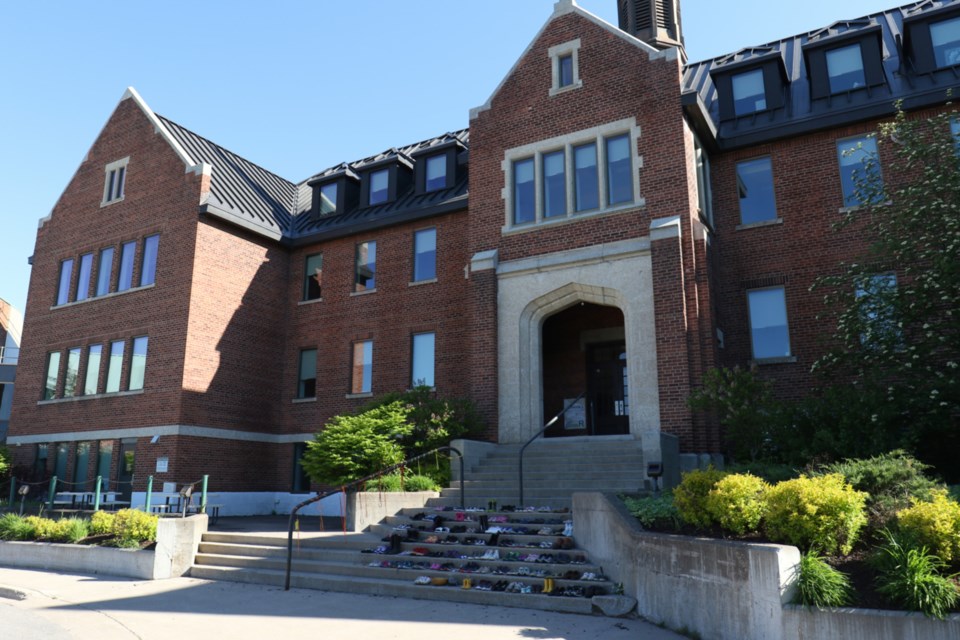Children of Shingwauk Alumni Association (CSAA) President Jay Jones says the $10 million earmarked by the province over the next three years to support the investigation into residential school burial sites is a “good start.”
But for those tasked with mapping out how an investigation into potential burial sites will take shape in Sault Ste. Marie, it’s only the beginning of the work that lies ahead. Jones says the alumni association, which includes survivors of Shingwauk Indian Residential School and family members, is currently in the early stages of establishing protocols and a project team for the investigation into potential burial sites locally.
“They’re very adamant about doing this properly and doing it correctly in the traditional sense, and being cognizant of people’s feelings that might be affected by this,” said Jones, speaking to SooToday from Waterford, Mich. Thursday. “We are in the process of creating some early-on protocols, so to speak.”
Initial discussions surrounding potential residential school burial sites in Sault Ste. Marie have consisted of alumni association members posing questions about the identification of burial sites to Dr. Paulette Steeves, a Tier II Canada Research Chair in Healing and Reconciliation at Algoma University and Paleo-Indigenous archaeologist.
Some of those questions honed in on the logistics and costs associated with ground-penetrating radar, which was used by Tk'emlups te Secwepemc Nation to to find what are believed to be the remains of 215 children at the site of the former Kamloops Indian Residential School.
According to the Truth and Reconciliation Commission of Canada, there were 18 residential schools in Ontario, leaving Jones to think that the $10-million commitment from the Ontario government over the next three years probably won't cut it.
“Paulette went to her friends that knew the answers, and then they came back with even more information than what we asked,” said Jones. “The more research we did and the more things that we found out - when I look at the big picture, $10 million over three years probably won’t be enough.”
Jones says the work needs to be done for those who wonder what happened to their family members who never returned home from residential school.
“The sooner we can act on this, the sooner these families can...not have closure, but put those feelings to rest,” he said.
Jones’ parents were both students at Shingwauk Indian Residential School, which was operated by the Anglican Church and the federal government from the early 1870s until it closed its doors in 1970. Vernon Jones attended from 1946 to 1948 - he successfully escaped and went back home to Walpole Island - while Susie Jones was a student there from 1941 to 1953. His uncle, Leo Kicknosway, was also a student at Shingwauk. Kicknosway is one of the 72 recorded student burials at the cemetery dedicated to Shingwauk staff and students.
Jones recalls long talks with his mother while travelling between Walpole Island and the Sault, in addition to the talks she would deliver at Truth and Reconciliation Commission events, where she would bring up her experiences as a student at Shingwauk.
“She would always say she was truly assimilated. She was taken when she was four-and-a-half, and she realized, even at a young age, that she had to adapt in order to survive,” said Jones. “She had to do what they wanted them to do, and the end result was that she was truly assimilated.”
Although no timeline has been set, Children of Shingwauk will gather with its partner organizations and institutions once it assembles its project team and establishes its protocols around how the work to identify potential burial sites in and around the former grounds of Shingwauk will proceed.
“We’re going to gather as a membership led by CSAA and the survivors - we will try to make the best decisions to benefit everybody, and do this in a manner where it’s respectful,” Jones said.
“We’re proceeding diligently, and we’re proceeding with the utmost care for the families involved, and we want to do this properly,” said Jones. “We want to try and include everybody in this process. We want to be as transparent as possible.”
“The Children of Shingwauk Alumni Association, they are the elders, they are the survivors - and they are the ones that will be making all the decisions. So I believe with this group of people, they will be very caring, and I think they will make the best decisions. They’re just an awesome group of folks to work with. I just love them.”
Over 150,000 Indigenous children were forcibly removed from their families and communities and sent to Indian Residential Schools between 1870 and 1996.
A national residential school crisis line has been established to provide support to former students and their families. The 24-hour crisis line can be accessed at 1-866-925-4419.
